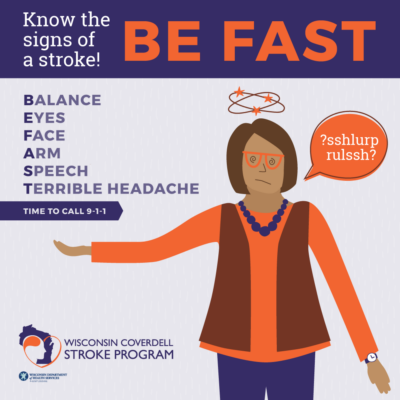 What is a Stroke?
What is a Stroke?
Rhonda Tesmer is a nurse at Stoughton Health and a Clinical Quality Specialist. She explains what a stroke is by comparing it to a heart attack. “Most people understand what a heart attack is, and I think it may be helpful if we think of stroke as a brain attack.”
Types of Stroke
An ischemic stroke occurs when the flow of blood to the brain is blocked. A hemorrhagic stroke occurs when a blood vessel in the brain bursts.
In both cases, parts of the brain can become damaged or die. A stroke can cause lasting brain damage, long-term disability, or even death. According to Tesmer, About 87% of all strokes are ischemic strokes where the blood flow is blocked.
While it’s important to stress that the risk for having a stroke increases as we age, you can have a stroke at any age.
BE FAST
It’s critical to know the signs of stroke. Time equals brain lost with brain cells dying without the flow of oxygenated blood. The acronym BE FAST can be helpful in remembering stroke signs and symptoms.
The B stands for balance, a sudden onset of dizziness or loss of balance or coordination.
The E stands for eyes, trouble seeing out of one or both eyes.
F stands for face, facial weakness with a droop or an uneven smile.
A is for arm, being unable to raise both arms evenly.
S is for speech, if the speech is impaired, slurred with difficulty repeating a simple phrase.
T is for a sudden onset of a terrible headache.
T also stands for time to call an ambulance now.
Call 911
If you or someone you know is experiencing any of these symptoms call 911 immediately and tell the operator this is a possible stroke. Calling 911 helps ensure that you receive the quickest treatment and diagnosis.
In the ER, they are going to do a very quick assessment and get the patient to the CT scan as rapidly as possible. The CT scan will help determine the type of stroke and the best course of treatment.
If there is no evidence of a hemorrhagic stroke or a brain bleed, the patient may be treated with the clot-busting drug tissue plasminogen activator or TPA.
Reduce Your Risk
Everyone can work to reduce stroke risk. Tesmer suggests “work with your primary care provider and identify your risks, stay compliant with your medication if you have high blood pressure or high cholesterol and be active. There’s so much that you can do to reduce your stroke risk.”

